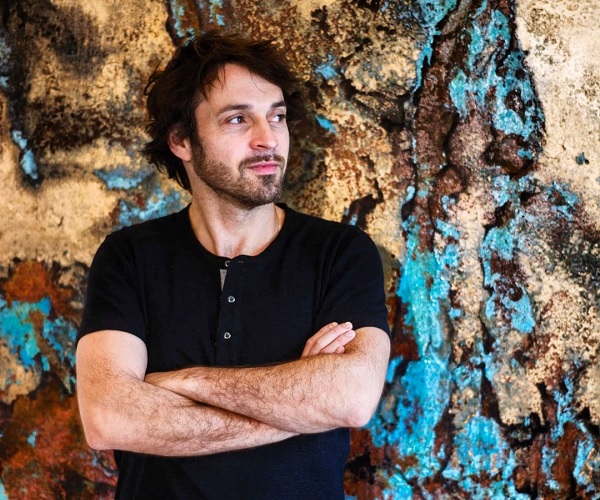
"Fortune rouge et sous cutanée" by Lionel Sabatté, winner of Luxembourg Art Prize 2020;
The name of the winner of the sixth edition of the Luxembourg Art Prize was revealed on 1 December 2020: Lionel Sabatté, a 44-year-old French artist living and working in Paris (France) and Los Angeles (California, USA), was chosen by the independent jury with the prize he won the €50,000 grant awarded by the Pinacothèque, a private museum which actively contributes to the influence of contemporary art in the Grand Duchy of Luxembourg.
This year, 12 finalist artists from all over the world were selected by the Pinacothèque for the 6th Luxembourg Art Prize 2020: the countries represented are: Germany, Brazil, Canada, Colombia, United States, France, Italy, Japan, Lithuania, Poland, Democratic Republic of Congo and United Kingdom.
Simultaneously a painter, a drawer and a sculptor, Lionel Sabatté tries to make all of his works dialogue in permanent interconnection. In short, his work on the mineral, the animal, and the organic gives rise to poetic, sensitive, troubling works that participate in a global reflection on our condition and the place we occupy in our environment. The realm of the living as well as the transformations of matter due to the passage of time lie at the heart of the artist's work. For several years, he has been collecting materials that carry with them the trace of lived experience - dust, ash, charcoal, dead skin, tree stumps and so on. These elements are unexpectedly combined and the works thus created carry within them both a delicacy and a "disturbing strangeness", thus giving life to a hybrid bestiary in which creatures from the abyssal depths rub shoulders with small birds from oxidised islands, bears, wolves, emus, and owls, as well as unicorns and more.
For the artist, his “oil and acrylic canvases open a dialogue with the other mediums within which my plastic universe unfolds all its richness. I use colours that have melted into one another and I attach paramount importance to the aqueous dimension that gives the work its organic, mineral aspect. Using vivid, contrasting touches, I echo the traces of time, perpetual natural changes and the movement inherent in all life. While patterns can emerge from these mystical paintings, which approach an aesthetic of chaos (in Greek mythology, "Chaos" is a primordial entity from which the universe is born), the imagination is left free for the spectator to discern something in each canvas--sometimes an eye, sometimes a bird, a jellyfish, a landscape seen from the sky, or even the sky itself."
The painting presented in his application for the Luxembourg Art Prize 2020 is an oil on canvas entitled "Fortune rouge et sous cutanée" ("Red fortune et subcutaneous"), 130 x 130 cm (51 x 51 in.), 2019. From this image strongly emerges an aspect that is both organic and mineral. Is this a macroscopic representation of the universe in which we find ourselves or, conversely, a microscopic detail of living things and the matter that compose them? It is up to the viewer to figure it out. What is the infinitely large if it is not a void that is undeniably structured very finely by matter? In this sense, the infinitely large undoubtedly resembles the infinitely small. There is always something inside of something ... The infinitely large and the infinitely small are inextricably linked to each other. The infinitely large cannot exist without the multitude of the infinitely small that composes it. Conversely, the infinitely small lives in an organized whole within the infinitely large without necessarily always realizing it. There is an immutable link between the two, and this link cannot be broken without risking the annihilation of both. From galaxies to atoms, there is a whole world that lies outside of our ordinary perception. This world opens up to us and extends its arms to us; free to embrace it ... A scientific mind would approach the question according to the fundamental theory of relativity, quantum physics, chaos and many others; while a more technical mind would tend to use a telescope and a microscope in order to observe one, sometimes the other. The artist prefers to use his technique, coupled with his knowledge, his desires and his imagination, to give free rein to his interpretation of the question and to offer it to as many people as possible. We must never stop asking questions...
About the Luxembourg Art Prize:
The Luxembourg Art Prize is an annual international artistic prize organised by the Pinacothèque, a private museum located in the Grand Duchy of Luxembourg. Every year it aims to discover talents, amateur or professional, regardless of age and nationality. This Prize is aimed at artists working in one or more of the following media: drawing, printing, installation, painting, photography, sculpture, mixed media, decorative art (textiles and material, glass, wood, metal, ceramics, mosaic, paper or other techniques). Since its creation in 2015, the Luxembourg Art Prize has aimed to reveal and promote talented and still unknown artists on the international contemporary scene. It also has a grant awarded each year to the laureate. For the 2020 edition, the sixth edition of the Luxembourg Art Prize, the grant awarded to the winner amounts to €50,000.

